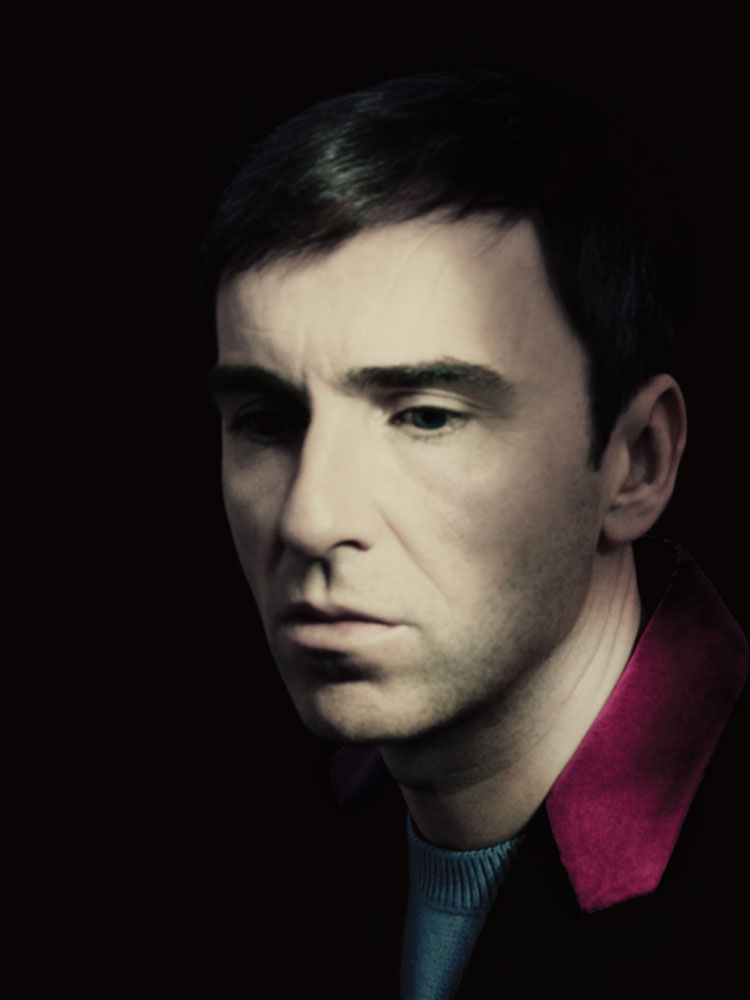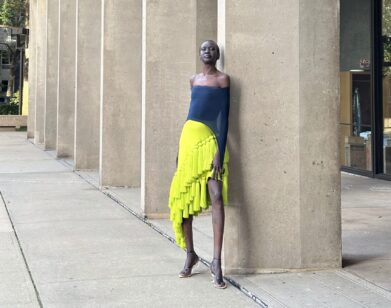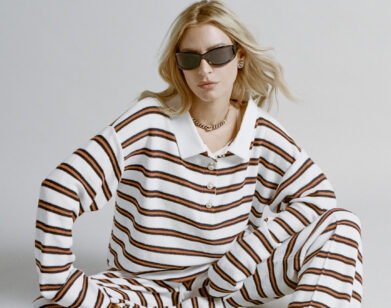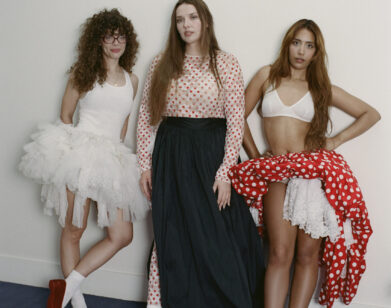Raf Simons
I never really have to sit at a desk thinking, ‘What should I do now?’ It doesn’t work like that for me, and it never has. My thinking process is constant. Raf Simons
Menswear is over for the season, haute couture is done, and Raf Simons is off to his favorite bolt-hole in Los Angeles for some vital R & R. A couple he has known for a long time have a midcentury cabin at the highest point in the Hollywood Hills, and they’ll leave him on his own there for a few days to enjoy the kidney-shaped pool, the huge deck with the panoramic view, and the coyotes. Simons will hit the galleries, the museums, some stores. The only thing he won’t do is go to the beach. “L.A. is a bit like Antwerp—relaxing and calm,” the 46-year-old Belgian designer says. “I never have the feeling that I have when I go to any other city, that I have to kind of make an agenda.” So he won’t do a single thing he feels he should do.
That satisfy-himself spirit has been the driving force behind one of the 21st century’s most influential careers. Simons has made a habit of challenging every verity, first poking the bear of menswear with his own eponymous line, which he launched in 1995, then stretching the parameters of minimalism at Jil Sander, and now dissecting the many facets of Christian Dior. But it’s too pat to pin him down as an iconoclast. So much thought and passion and romance go into what he does that he’s more a poet than anything else. A new kind of poet, that is. In mid-January, he showed his latest Raf Simons menswear collection in Paris, this time, sharing creative control with artist Sterling Ruby in a remarkable marriage of the artist’s chaos and the designer’s discipline. Less than a week later, in the same spirit of opening up to new possibilities, his couture collection for Dior hinted at revelation: neat little sheaths veiled in silk, dresses covered with a lattice of cutwork, layers that artfully winked open to reveal the female form. The technique was spectacular but the lingering impression was lightness, airiness, energy, “a younger aesthetic for a younger mentality,” says Simons.
But that has always been his ethos. Which means that, even though his nearly two years thus far as artistic director at Dior has given him a startling new page on which to write, his voice remains as distinctively his as it was nearly 20 years ago when he first showed the world the dark angels in his mind.
TIM BLANKS: Can you see stylistic connections between the many things you do, from your own collection, to couture for Dior, ready-to-wear, pre-fall, the whole range?
RAF SIMONS: You do what you do. Or you do what you have to do. I don’t know how to explain it better. I think that in the moment, you can’t see connections, but sometimes afterwards you do. My own show with Sterling Ruby, for example, seems like such a huge disconnection from Dior couture, but then I think, yeah, in both collections there was a very strong focus on the human hand and the actual work of people making garments. So in that sense, they were completely related. But I didn’t realize that during the process.
BLANKS: But I imagine the research process is vastly different. The psychology of your own show versus the psychology of Dior couture, for instance.
SIMONS: I never really have to sit at a desk thinking, “What should I do now?” It doesn’t work like that for me, and it never has. My thinking process is constant. The difference is that once I was in Antwerp only doing two men’s shows a year. And the weird thing is I thought I was busy then.
BLANKS: So when you hear a piece of music or read something or see a movie that triggers an idea in your mind, where do you locate that germ of inspiration in everything you’re doing?
SIMONS: I don’t find it difficult anymore, because these days, Raf is only men and Dior is only women. I found it much more complicated when I was doing Jil Sander for men and women. It wasn’t that it was the same, but I’m specific about where I want to go, and when you suddenly have to do two men’s collections in the same moment, that was more difficult. Also, with Jil, it was more complicated because I found the whole heritage thing there less … um … What can I say?
BLANKS: Less inspiring than you thought it would be?
SIMONS: In the long run, yes. The Dior heritage is so broad. It has a strong presence in the work. So, when people have to define it quickly, it’s, like, the Bar jacket and the movement and the luxury and the Belle Époque and so much more. But when we talked about Jil, it was always the same things—the purity, the minimalism, the strictness—but, in fact, I found them very limiting after a few years. I always try to connect with what’s happening in the world-reality, modernity, the 21st century, all that—and with Jil it started to feel very disconnected from the outside and how women were looking at fashion, experiencing fashion, interpreting fashion. It felt wrong for me to stay totally connected to that very strict way of approaching the heritage—what it can be, what it cannot be. That was also the period where I really thought, “No, let’s open it up.”
BLANKS: Don’t you think it’s also simply that the Jil Sander heritage was slightly dry and the Dior one is much richer culturally?
SIMONS: I would prefer to use the word free. I think the Dior thing is so much freer. There was not so much free about Jil’s way of working.
BLANKS: But don’t you think that’s also a reflection of a change in the way you respond to things as you mature?
SIMONS: Well, my own men’s collection always felt very free back in the days before Jil. Once you make it this kind of dialogue with other people, with a fashion show and clients and whatever, it becomes something else. Free meets not so free. It was a challenge for me to see how I could deal with that at Jil, and I had a lot of doubt about it. I wondered if maybe it was just better to do your own thing in the long run, like an artist. Becoming a fashion designer is agreeing with the fact that what you experience or what you see as free is also connected to a system. Does that mean giving up your freedom? I still don’t know the answer. There’s a very different kind of psychology going on in the fashion scene than in art. When artists connect to a system because they want to make a living, it’s their own choice. In fashion, designers don’t have that choice. I know everybody mentions Azzedine Alaïa, but he’s been going for a long time in the system—showing to people, selling to clients—and I think it’s admirable how he’s transformed it into his own system in a way, but it’s still a system.
BLANKS: But surely it’s exactly the same for artists. A gallery shows their work, sells it to collectors.
SIMONS: No, not all of them. Robert Gober, for example. He doesn’t seem like somebody who is just going to show in a gallery that asks him to show. He’s just making his work, and when he’s ready, he’s going to show it.
BLANKS: Mmm … just like Alaïa.
SIMONS: Voilà! But how did we get onto systems?
BLANKS: Well, I’ve often thought the reason why you function so well is because you’re an outsider. You weren’t part of the system to begin with.
SIMONS: I know. And even being in the middle of it, at the LVMH group with Dior, there are certain parts of it that I’m just not really in, because it’s not in me or my nature. The whole scene around it, the events, the photography … It’s never really been my thing. But I don’t take a critical position on people who are very much about that either.
BLANKS: So would you describe yourself as an outsider then? Like an outsider artist or an outsider musician, somebody who can go into the mainstream, but still maintain his objectivity?
SIMONS: I find the comparison with the outsider artist difficult, because I think outsider art very often doesn’t fit into contemporary art.
BLANKS: Except at last year’s Venice Biennale.
SIMONS: But that was for reasons other than the fact that the artist doesn’t fit the system. I think it’s different in fashion, because even if I would be an outsider, I would still be in the middle of the whole world of contemporary fashion. But it’s interesting to think what outsider fashion could be. Does it mean to be completely disconnected from the regular system or just disconnected style-wise?
BLANKS: Or it’s a way to introduce thought processes that are not dictated by the way things have always been. I mean, when you talk about the psychology of fashion—the psychology of a woman’s world, a closed society—it’s not something that a lot of other designers ever bring up.
SIMONS: When it’s only clothes, that is not satisfying enough for me. I don’t think I could do this for 10, 20 years if that was all. It also has to be about a psychology or a mentality or a concept. I’ve always seen myself as a small entity, and it will always stay like that. I’m not changing. But I think the big challenge for me taking on the Dior thing is to see how I can connect that to such a huge institution. I see my position in that whole Dior construction very differently from my own brand. My own brand will stand or fall because of me. Dior won’t fall if I fall. It will also still stand if I’m not there. I’m coming in there and it’s like a—I don’t know the English word—like a passage.
BLANKS: Like being a hired hand? You come in, you run the ranch, all the horses are happy and healthy, and then you’re not there anymore. It’s somebody else’s responsibility.
SIMONS: Yeah, but the psychology for the person who’s actually doing it is completely different. I think I probably needed to put that [hired-hand] psychology in my own head to be able to do the job. Otherwise it would just be too scary. People outside make it much bigger than me. I’m not saying in my head, “Oh, my god, what an amazing idea!” It scares me if I would do that.
BLANKS: That fear has certainly never come across. I think about the day before your first couture show, in July 2012, when I walked into the Dior offices on rue François 1er and you were just hanging out in the lobby without the remotest suggestion of stress or tension, and it really stayed with me that the reason why you could do that is because you did see yourself as the hired hand. You would go and do what you were hired to do—
SIMONS : In my way.
Becoming a fashion designer is agreeing with the fact that what you experience or what you see as ‘free’ is also connected to a system. Does that mean giving up your freedom? I still don’t know the answer. Raf Simons
BLANKS: In your way, but ultimately it wasn’t going to destroy you if it didn’t work out. That’s what I mean about being an outsider.
SIMONS: You are right. But I’m a fragile person, as well. I’m an emotional one.
BLANKS: Oh, I know, you cry like a baby at the drop of a hat. [both laugh] So do I.
SIMONS: But then, on the other hand, I think that it’s just not in me to make the drama. Although there is drama sometimes. All designers are egocentric in a way, and in that sense, I’m not different from anyone else. But I hope I’m on a lower percentage of egocentricity than lots of other people.
BLANKS: You have to be the controller. Being a designer is like being a director. You’re realizing your vision through the efforts of a lot of other people. But you seem very generous with that kind of power.
SIMONS: Well, I think I could do things all by myself in a very different kind of practice, like doing ceramics or something. When I was studying industrial and furniture design in Genk, it felt very much like me on my own. The reason I decided against it was because I thought it would be so nice to be in this kind of social environment, to always have a dialogue with people and a constant collaboration. In that way, fashion felt very alive. And then afterwards, the fashion thing became very intense, and I was thinking, “Well, maybe I am somebody who likes to do more things by myself.” That’s why I stopped in 2000. Then I missed it again. So, yeah, I guess I am not always so clear about myself.
BLANKS: What was clear was that you were very much of your generation, absorbed by the doomed romance of youth, the sense of the finite—closed worlds that just sort of flutter and die—that carries through your own work to Dior.
SIMONS: When we were young, everything slid together much more. The music, the magazines, the imagery, they all felt like part of one world. I find that today is more complex, or maybe less complex … I don’t know if it is because I got old or it just changed. When I talk with Jo-Ann Furniss or Peter Saville or Olivier Rizzo or Willy Vanderperre or you, it’s the same mindset, the same way of seeing things that we had when we were young. I find young people über-fascinating, but I don’t feel that they look at things in the same way. For us, there was more mystique. Everything was more difficult to find. You had to really look for something special. I don’t know, do we all coincidentally come from environments where interesting things weren’t given to you? I was looking out of my window, and the only thing I saw in the street was a cow [in Neerpelt, Belgium, where Simons was born]. There was no cinema, there were no galleries, so that made it much more interesting that you had to look for those things.
BLANKS: And glamorous, too.
SIMONS: Glamorous? I think I was not so glamorous.
BLANKS: No, I mean you had to go to the library to find stuff out about Andy Warhol. And that stuff was glamorous.
SIMON: In the beginning, it was not so much fashion for me. I was more connected to art. I was trying to go as often as possible to the movies. The fashion thing came later, in a way, because of Martin [Margiela]. The whole Belgian thing was around me, and that made me go into it more.
BLANKS: Do you think there was an element of escape in all of that? You say you looked out the window and saw a cow. Obviously, you wanted to escape from that world.
SIMONS: Today, I would be so happy if I were to look out my window and see a cow. [laughs] But when you’re a kid, you like to go out, you like to go to a club and all that kind of stuff. It was that simple. I think it connects to a lot of things, to the fact that you know early on that all this here is too small. Maybe small is not the right word. I don’t want to make it sound like I felt bigger or I felt more special than my environment, but I knew it wasn’t a match. Maybe not when I was 12 because I was always hanging out with all the kids on the farms, but by 15, 16, I felt it already: street, farms, college, it wasn’t a match. I went to a very classic college where they wanted you to become a doctor and all that, and I didn’t relate at all. I think also, in the beginning, I didn’t really realize that there was another way of doing things or that there was another way of searching. There was no computer, there was no cellphone.
BLANKS: There was only music and magazines.
SIMONS: And in my case, it was even more difficult because the village where I was living definitely didn’t get i-D Magazine or The Face. I think it’s why there are things that are in your heart forever because of the time that you found them. You know how people keep something with them—it could be a little handmade cushion, it could be anything, but you have to cherish it.
BLANKS: Oh, reliquaries, aides—mémoire, souvenirs …
SIMONS: My generation has a lot of that. We were full of obsessions. I sometimes ask kids what their obsession is, and there are so few who have an obsession. If I ask, “What’s your favorite band?” nine times out of ten, they’ll answer, “Oh, I like a lot of music.” We weren’t like that at all. “What’s your favorite band?” “Kraftwerk.” You got it before you were asked it. I don’t feel that now. But it’s not a critique, because this is a generation of people that you have to pay attention to. They’re going to define our new world.
BLANKS: I’m curious about something like Dior, say, which has given you a huge platform to explore your obsessions. Will you go back to obsessions you’ve always had, to explore them more completely? I thought this Spring 2014 couture collection was quite obsessive: the idea of opening up, of revelation … the sense of something seen but not seen. It felt very sexual to me.
SIMONS: I feel it’s more at a stage where I’m already allowed to experiment a bit more with the brand. I find it very satisfying, because it took me a long time to have that feeling at Jil. Here at Dior, we’ve done 10 shows already so there’s more interaction. Everything moves faster when you’re doing six shows a year instead of two. And I can see it’s working, and that is very challenging, because I think people want Dior to …
BLANKS: Be more radical?
SIMONS: Well, we could put a lot of definitions on it. But before I came, I would not have expected people to react so fast. The women who wear it and the women who want to wear it really do react very fast. That’s what fascinates me the most, because you also have to make this split between ready-to-wear and couture. But specifically couture, I do find, is in a problematic situation. It has evolved over so many decades to a psychology that I personally do not relate to at all. I don’t understand why, in the evolution of fashion, couture should be redefined after the birth of ready-to-wear. Before, everything was couture. Couture was just making clothes for people.
BLANKS: Exactly. Entire wardrobes. Balenciaga made gardening clothes for Daisy Fellowes.
SIMONS: Obviously, with the birth of ready-to-wear, there were new rules for couture to make it as exclusive and unique as possible, and I’m fine with that, because otherwise what would make it different? But what I don’t understand is why it became this incredible don’t-touch thing that people just look at. For me, it’s the opposite. I want it to be a thing that women want to wear, because it’s unique to them. But my point is more that there is a young generation out there with an interest in fashion, and they almost think about couture as something that has to be out of reach. And they get aggressive at the idea that couture can relate to the 21st century women. That is, for me, completely shocking.
BLANKS: For real?
SIMONS: Go on the blogs. There are people who, if they see something in couture that they perceive as ready-to-wear, they’re in shock.
BLANKS: There were absolutely all those comments when you started at Dior like, “That’s not couture!”
SIMONS: Voilà, that’s the point. But if I do that and that and that, and it’s done by hand in a couture house, which works with a client because that’s what the client wants, then it’s couture. It’s not because it is 75 meters of fabric that it’s couture. I can do a 75-meter fabric piece in ready-to-wear that’s going to impress everybody. And produce 300 afterwards. [both laugh] Anyway, people can’t see what couture is very well on a computer screen.
BLANKS: Can you see how your presence in the world of couture has loosened things up a little bit?
SIMONS: I hate to say it because it sounds so pretentious, but I do see it. And I think I can say it because I also have the feeling that I really had to fight for it. With the first few collections, I was still quite knocked around the head for doing it, and I found that very hard. I was especially fragile around the couture.
BLANKS: Because clients were feeding back to you more immediately?
SIMONS: The clients were absolutely lovely. From the first moments, they were quickly into it and reactive. It was the press who were more complicated in this case.
BLANKS: What was more useful for you: praise or criticism?
SIMONS: In the end, criticism. I know from situations over the last 18 months that having a direct dialogue about the actual criticism has led to me learning things I didn’t know.
BLANKS: Do you like to provoke people?
SIMONS: I never really overthink my work in relation to “What should we do to make it look shocking or special or extreme?” We just do the things we think we need to do.
BLANKS: So would you rather seduce people or disturb them?
SIMONS: I think it’s a nice balance to have both. That is the most fascinating work: when there is something that you don’t agree with or that disturbs you, but at the same time, attracts you. And you think it over. The worst, for me, is if I see a show and I don’t think it over.
TIM BLANKS IS A LONDON-BASED JOURNALIST AND WRITER. HE IS CURRENTLY THE EDITOR AT LARGE OF STYLE.COM.







